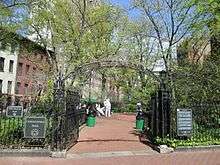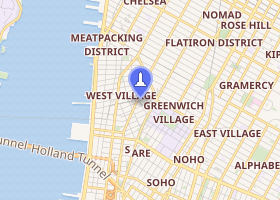Gay Liberation Monument
The Gay Liberation Monument is a monument featuring the sculpture Gay Liberation by American artist George Segal, located in Christopher Park along Christopher Street in the West Village section of Manhattan, New York. Located at the northern end of the park, the art installation commemorates the Stonewall riots[1] and features four figures (two standing men and two seated women) positioned in "natural, easy" poses.[2] The bronze statues are covered in white lacquer, cast in 1980 from plaster moulds of human models. Two "World's Fair-style" benches and a plaque are also part of the monument.[2] The monument was dedicated on June 23, 1992, and is part of the Stonewall National Monument.
| Gay Liberation | |
|---|---|
 The memorial as seen from one of the park's entrances | |

| |
| Artist | George Segal |
| Year | 1980 |
| Type | Sculpture |
| Medium | Bronze |
| Location | New York City; Stanford, California |
| 40°44′01″N 74°00′09″W | |
The sculpture was originally commissioned in 1979 (10th anniversary of the Stonewall incident) by the Cleveland-based Mildred Andrews Fund. The commission specified that the work must be installed on public land and that it "had to be loving and caring, and show the affection that is the hallmark of gay people. . . . And it had to have equal representation of men and women." It was completed in 1980 and was the first piece of public art dedicated to LGBT rights.[3] It was intended for installation in New York but proved too controversial for the city. It was instead installed in Orton Park in Madison, Wisconsin from 1986 to 1991. The Madison installation was funded by the New Harvest Foundation. It was finally moved to New York in 1992. After it was moved to New York, one of the Stonewall veterans, Marsha P. Johnson, commented, "How many people have died for these two little statues to be put in the park to recognize gay people? How many years does it take for people to realize we're all brothers and sisters in the human race? We're all in this rat race together."[4]
In August 2015, anonymous activists painted two of the figures' faces brown to protest the way the statues "white- and cis-wash a movement led by black and brown queer and trans people".[5][6]
Stanford University
A second casting of the work was intended for Los Angeles but was also refused by the city. In 1984 it was installed on Stanford University's Main Quad as a "long term loan". The sculpture was vandalized several times during the first ten years, but eventually became an accepted part of Stanford's public art.[7]
References
- Dunford, Martin (2009-01-02). The Rough Guide to New York City. Penguin. p. 190. ISBN 9781848368262. Retrieved June 25, 2014.
- "Christopher Park: Gay Liberation". New York City Department of Parks and Recreation. Retrieved June 25, 2014.
- "George Segal's Gay Liberation". GLBTQ Encyclopedia. Archived from the original on 24 November 2014. Retrieved 18 August 2014.
- "Pay It No Mind: The Life and Times of Marsha P. Johnson". Retrieved July 8, 2017.
- Orangias, Joe Joe, Jeannie Simms, & Sloane French (2017). "The Cultural Functions and Social Potential of Queer Monuments: A Preliminary Inventory and Analysis". Journal of Homosexuality. 65 (6): 705–726. doi:10.1080/00918369.2017.1364106. PMID 28777713.
- "Anonymous Activists Just Painted The Stonewall Statues Brown For Miss Major". Autostraddle. 2015-08-18. p. 1. Retrieved August 18, 2015.
- "George Segal's Gay Liberation: Move to Stanford". glbtq, Inc. p. 2. Archived from the original on November 24, 2014. Retrieved August 7, 2014.
External links
